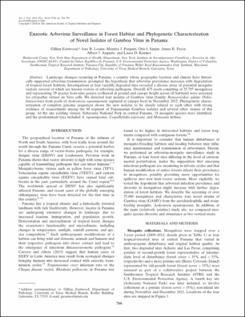Mostrar el registro sencillo del ítem
Enzootic Arbovirus Surveillance in Forest Habitat and Phylogenetic Characterization of Novel Isolates of Gamboa Virus in Panama
| dc.contributor.author | Eastwood, Gillian | |
| dc.contributor.author | Loaiza, Jose R. | |
| dc.contributor.author | Pongsiri, Montira J. | |
| dc.contributor.author | Sanjur, Oris I. | |
| dc.contributor.author | Pecor, James E. | |
| dc.contributor.author | Auguste, Albert J. | |
| dc.contributor.author | Kramer, Laura D. | |
| dc.date.accessioned | 2020-07-08T04:50:12Z | |
| dc.date.available | 2020-07-08T04:50:12Z | |
| dc.date.issued | 2016-04-06 | |
| dc.identifier.other | https://doi.org/10.4269/ajtmh.15-0445 | |
| dc.identifier.uri | http://repositorio-indicasat.org.pa/handle/123456789/184 | |
| dc.description | Landscape changes occurring in Panama, a country whose geographic location and climate have historically supported arbovirus transmission, prompted the hypothesis that arbovirus prevalence increases with degradation of tropical forest habitats. Investigations at four variably degraded sites revealed a diverse array of potential mosquito vectors, several of which are known vectors of arbovirus pathogens. Overall, 675 pools consisting of 25,787 mosquitoes and representing 29 species from nine genera (collected at ground and canopy height across all habitats) were screened for cytopathic viruses on Vero cells. We detected four isolates of Gamboa virus (family: Bunyaviridae; genus: Orthobunyavirus) from pools of Aedeomyia squamipennis captured at canopy level in November 2012. Phylogenetic characterization of complete genome sequences shows the new isolates to be closely related to each other with strong evidence of reassortment among the M segment of Panamanian Gamboa isolates and several other viruses of this group. At the site yielding viruses, Soberanía National Park in central Panama, 18 mosquito species were identified, and the predominant taxa included A. squamipennis, Coquillettidia nigricans, and Mansonia titillans. | en_US |
| dc.description.abstract | Landscape changes occurring in Panama, a country whose geographic location and climate have historically supported arbovirus transmission, prompted the hypothesis that arbovirus prevalence increases with degradation of tropical forest habitats. Investigations at four variably degraded sites revealed a diverse array of potential mosquito vectors, several of which are known vectors of arbovirus pathogens. Overall, 675 pools consisting of 25,787 mosquitoes and representing 29 species from nine genera (collected at ground and canopy height across all habitats) were screened for cytopathic viruses on Vero cells. We detected four isolates of Gamboa virus (family: Bunyaviridae; genus: Orthobunyavirus) from pools of Aedeomyia squamipennis captured at canopy level in November 2012. Phylogenetic characterization of complete genome sequences shows the new isolates to be closely related to each other with strong evidence of reassortment among the M segment of Panamanian Gamboa isolates and several other viruses of this group. At the site yielding viruses, Soberanía National Park in central Panama, 18 mosquito species were identified, and the predominant taxa included A. squamipennis, Coquillettidia nigricans, and Mansonia titillans. | en_US |
| dc.language.iso | eng | en_US |
| dc.rights | info:eu-repo/semantics/openAccess | |
| dc.rights | https://creativecommons.org/licenses/by-nc-sa/4.0/ | |
| dc.subject | Enzootic | en_US |
| dc.subject | Arbovirus Surveillance | en_US |
| dc.subject | Forest Habitat | en_US |
| dc.subject | Phylogenetic Characterization | en_US |
| dc.subject | Novel Isolates | en_US |
| dc.subject | Gamboa Virus | en_US |
| dc.subject | Panama | en_US |
| dc.title | Enzootic Arbovirus Surveillance in Forest Habitat and Phylogenetic Characterization of Novel Isolates of Gamboa Virus in Panama | en_US |
| dc.type | info:eu-repo/semantics/article | en_US |
| dc.type | info:eu-repo/semantics/publishedVersion |

